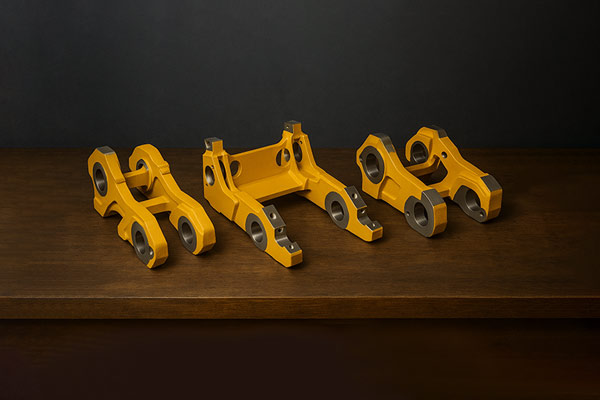The Unsung Heroes: Understanding Bogie Systems in Heavy Machinery
At its core, a bogie is an independent assembly of wheels or tracks that supports a portion of the machine's weight and provides articulation, allowing the machine to navigate uneven surfaces without putting undue stress on the main chassis. Think of it as a specialized, heavy-duty suspension system designed for the most demanding environments.
The Front Bogie
The front bogie is often the workhorse when it comes to steering and initial load distribution. In many heavy machines, especially those designed for high-speed travel or precise maneuvering, the front bogie plays a pivotal role in directing the machine's path.
- Steering Mechanism: Unlike the simple pivot of a car's front axle, a front bogie can incorporate complex steering geometries, sometimes with multiple steering axles or even individual wheel steering. This allows for tighter turning radii and improved maneuverability in confined spaces.
- Weight Distribution: It's the first point of contact with obstacles and uneven ground, meaning it absorbs and distributes significant shock loads. Its design often prioritizes robust construction and effective damping to protect the rest of the machine.
- Stability: A well-designed front bogie contributes significantly to the overall stability of the machine, especially when operating on inclines or during turns, preventing tipping or loss of control.
Consider a large articulated dump truck: its front bogie is crucial for navigating winding haul roads and maintaining stability under a massive payload. UCASLAR bogie parts are produced of high quality so you can be sure that they will work in any harsh conditions.
The Rear Bogie: Bearing the Brunt
- Load Bearing Capacity: Rear bogies are engineered to withstand enormous static and dynamic loads. In machines like excavators or cranes, the rear bogie often supports the counterweight and the massive forces generated during lifting or digging operations.
- Traction and Power Transfer: In many heavy machines, the drive wheels or tracks are located on the rear bogies. This means they are responsible for transmitting engine power to the ground, providing the necessary traction to move the machine, especially up slopes or through soft terrain.
- Articulation and Ground Contact: Multiple axles within a rear bogie system allow the wheels or tracks to maintain continuous contact with the ground, even over highly uneven surfaces. This improves traction, reduces stress on individual components, and enhances overall stability.

Beyond Front and Rear: Other Bogie Systems
The world of heavy machinery is diverse, and so are its bogie systems. Depending on the machine's function and design, you might encounter other specialized bogies:
- Track Bogies (Undercarriages): In track-driven machines like excavators, bulldozers, or track loaders, the "bogie system" refers to the entire undercarriage assembly. This includes idlers, rollers, sprockets, and track frames, all working together to distribute the machine's weight, provide propulsion, and absorb shock. These are arguably the most complex bogie systems, designed for maximum ground contact and maneuverability in extreme conditions.
- Tandem Bogies: Often found on large trucks or trailers, tandem bogies consist of two closely spaced axles that share a common suspension. This configuration allows for better weight distribution over multiple axles, increasing load capacity and reducing ground pressure.
- Walking Beam Bogies: A common sight on off-road trucks and forestry equipment, walking beam bogies use a central pivot point that allows the wheels on either side to move independently, providing excellent articulation and ground contact over very rough terrain.
- Specialized Bogies for Cranes and Mobile Equipment: Cranes, for instance, might have multi-axle bogies designed for exceptional stability during lifting operations, often incorporating hydraulic leveling systems to ensure a perfectly level base on uneven ground.
Check out more undercarriage parts here
The Importance of Bogie Systems
The design and maintenance of bogie systems are paramount for:
- Operational Efficiency: Proper bogie design reduces stress on other components, leading to less downtime and increased productivity.
- Safety: A stable machine with good ground contact is a safer machine to operate, especially in challenging environments.
- Durability and Lifespan: By effectively distributing loads and absorbing shocks, bogie systems protect the main chassis and other vital components, extending the overall lifespan of the machinery.
- Versatility: Different bogie systems allow machines to be optimized for specific tasks and terrains, from smooth highway travel to extreme off-road work.
In conclusion, while they might not always be in the spotlight, front bogies, rear bogies, and other specialized bogie systems are the backbone of heavy machinery. The most popular parts for bogies are 7T5416, 7T5417, 17M-30-56151, 17A-30-46151, 9W7613 and others. Check out more info here and more parts at our store
Their sophisticated engineering ensures these powerful machines can move, operate, and perform their essential tasks with stability, efficiency, and unwavering reliability, even in the most demanding environments on Earth!






